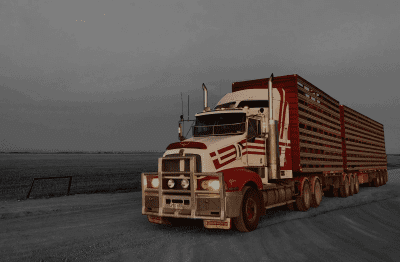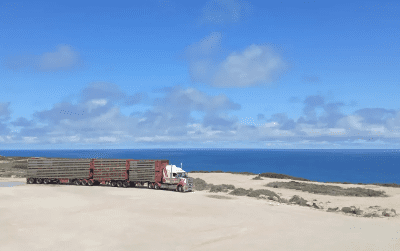FROM a single truck in 1988 Robert Cavanagh has built a nationally significant livestock transporting business through strategic acquisitions, industry insight and growing with his customer base.
Hailing from a beef and dairy farming background at Casino, Rob entered the livestock transporting industry in 1985, initially driving for Jim and Helen Savage’s livestock carting business at Tamworth, later to become Stockmaster.
 In 1988 Rob started Cavanaghs Transport with the purchase of his own truck, sub-contracting for Jim and Helen in addition to carting cattle for producers around his hometown of Casino.
In 1988 Rob started Cavanaghs Transport with the purchase of his own truck, sub-contracting for Jim and Helen in addition to carting cattle for producers around his hometown of Casino.
A big step forward for the fledgling one-truck business came in 1995 when Rob relocated Cavanaghs Transport to Inverell to support the McDonald family’s growing Bindaree Beef abattoir.
A second truck was added in 1988, and by 2007, the fleet had grown to eight trucks, primarily hauling cattle from northern NSW and Queensland into the Bindaree abattoir.
A further major advance for the business came in 2010 when the opportunity emerged to buy Stockmaster from Jim and Helen Savage.
further major advance for the business came in 2010 when the opportunity emerged to buy Stockmaster from Jim and Helen Savage.
Rob said he wasted no time seizing the opportunity to buy Stockmaster as he knew the business and its shared values well.
Cavanaghs Transport and Stockmaster were operated as separate businesses for 11 years, with both individually appearing on Beef Central’s previous list of Australia’s largest livestock transporters in 2013 (Stockmaster at No.12 with 21 prime movers and 60 decks and Cavanaghs at No. 22 with 10 prime movers and 40 decks)
Cavanaghs Transport and Stockmaster merged in 2021 and are today run as a single business, Cavanaghs Transport.
 The fleet today comprises 26 prime movers operating with B-doubles, B-triples and road trains – almost exclusively Kenworth trucks and Byrne trailers – operating out of two depots in Inverell and Tamworth and covering a footprint that covers the entire eastern half of the continent.
The fleet today comprises 26 prime movers operating with B-doubles, B-triples and road trains – almost exclusively Kenworth trucks and Byrne trailers – operating out of two depots in Inverell and Tamworth and covering a footprint that covers the entire eastern half of the continent.
“We have a very large footprint,” Rob said. “We do cattle out of South Australia and from Mortlake (in Victoria) to Charters Towners (in Nth Qld).
“We’re the national carriers for Bindaree, and a number of long-term blue-chip clients.”
A shifting livestock landscape
Traditionally more cattle-focused, Rob said that today Cavanaghs Transport operates on a 50-50 split between sheep and cattle transportation.
The key, as he explained to Beef Central, is maximising efficiency through “loaded kilometres” – ensuring that trucks carry livestock in both directions to optimise profitability.
“In 2013 we probably only had 8 or 9 sheep crates, our sheep crate fleet has grown considerably, and our cattle crates have downsized in number,” Mr Cavanagh said.
“It is just more profitable – you can load your trucks both ways. Down with sheep then turn around and do cattle north. It is all about trying to get loaded kilometres.”
Evolution of fleet and technology
Rob said safety and compliance have been perpetual priorities for the business, with the company embracing Advanced Fatigue Management (AFM) and cutting-edge technology, including Guardian Seeing Eye Machines, which track drivers’ eye movements to prevent fatigue-related incidents. New trucks also feature lane departure warnings and adaptive cruise control, further enhancing safety.
Future opportunities
Asked if he believes opportunities exist for young people to create the same type of business he was able to start from scratch 30 years, Rob didn’t hesitate to say yes.
“I’ve never seen so much potential out there and so few willing to have a crack,” he says.
“You can get the right money for your work today, if you’re coming up through the ranks there is unbelievable opportunity.
“A few years ago we thought if we had one million head of cattle on feed it would be hard to keep up with, now we have 1.4 million cattle on feed.
“Most of them get sold and get a trip around the backgrounding paddocks before they even get to a feedlot.
“A lot of inter feedlot transfers also happen today. The job is only growing.”
Leadership
As a senior statesman of the industry today Rob’s influence in the Australian livestock transporting sector extends far beyond his own company.
He has served in leadership roles across industry organisations, including the Australian Livestock and Rural Transporters Association (ALRTA) and the NSW Livestock, Bulk and Rural Carriers Association (LBRCA).
His contributions were recognised in 2018 when he was awarded Life Membership with ALRTA.
Looking ahead, succession planning is on the horizon. His daughter, an experienced corporate professional in agricultural banking, will be joining the business later this year.
Tackling the workforce shortage
While his business has grown, Rob acknowledges that livestock transport remains a niche segment, accounting for less than two percent of the entire transport industry.
The small footprint makes finding skilled drivers increasingly difficult.
“We’ve lost our nursery,” he laments, referring to the traditional pathway where young people from rural backgrounds would enter the industry.
With many rural kids opting for university and corporate careers instead, fewer are returning to truck driving.
Historically, he noted, shearers make great truck drivers, bringing discipline and a thorough understanding of livestock. However, with the decline of shearing teams in regions like Blackall and Longreach, that pipeline has also diminished.
To address such workforce challenges, Rob is exploring international recruitment. His company has already begun hiring workshop staff from the Philippines—a move he describes as a “game changer.” Now, he is working on a pathway to bring in overseas truck drivers, potentially from Europe.
“We have to start thinking differently about where we find staff,” he says. “Abattoirs are already sourcing workers through the Pacific Island program. The transport industry needs to follow suit.”
Beyond recruitment, Rob believes in training from within. Over 80 percent of his workforce has been trained in-house, a model he sees as essential for sustaining the industry. Despite excellent efforts from companies like Frasers to implement training programs, he said attracting new talent remains an uphill battle.
Click here to return to Top 25 Transporters feature, or click here to return to the table of Top 25 entries.



Being an ex cattle transport company, I find these articles very inspiring to up and coming livestock people. Back in 1987, never did we realise the huge amount of livestock that would have to be shifted by road transport. Especially feedlot cattle. I’m enjoying reading these stories. Regards to all.